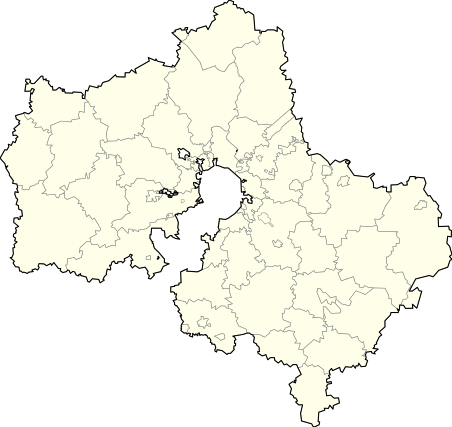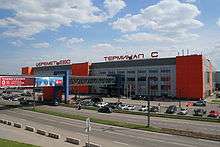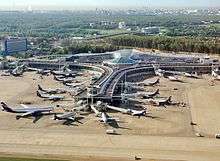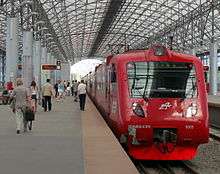Sheremetyevo International Airport
| Sheremetyevo International Airport Международный аэропорт Шереметьево | |||||||||||||||
|---|---|---|---|---|---|---|---|---|---|---|---|---|---|---|---|
|
| |||||||||||||||
|
| |||||||||||||||
| IATA: SVO – ICAO: UUEE | |||||||||||||||
| Summary | |||||||||||||||
| Airport type | Public | ||||||||||||||
| Operator | International Airport Sheremetyevo | ||||||||||||||
| Serves | Moscow, Russia | ||||||||||||||
| Location | Khimki, Moscow Oblast | ||||||||||||||
| Hub for | |||||||||||||||
| Elevation AMSL | 192 m / 622 ft | ||||||||||||||
| Coordinates | 55°58′22″N 037°24′53″E / 55.97278°N 37.41472°ECoordinates: 55°58′22″N 037°24′53″E / 55.97278°N 37.41472°E | ||||||||||||||
| Website | svo.aero | ||||||||||||||
| Map | |||||||||||||||
 UUEE Location in Moscow Oblast | |||||||||||||||
| Runways | |||||||||||||||
| |||||||||||||||
| Statistics (2015) | |||||||||||||||
| |||||||||||||||
Sheremetyevo International Airport (Russian: Международный Аэропорт Шеремéтьево; IPA: [ʂɨrʲɪˈmʲetʲjɪvə]) (IATA: SVO, ICAO: UUEE) is an international airport located in Khimki, Moscow Oblast, Russia, 29 km (18 mi) northwest of central Moscow. It is a hub for passenger operations of the Russian international airline Aeroflot, and is one of the three major airports that serve Moscow, along with Domodedovo International Airport and Vnukovo International Airport (the IATA city code for Sheremetyevo, Domodedovo, and Vnukovo is MOW). In 2015, the airport handled 31,612,402 passengers and 256,104 aircraft movements, making the airport the busiest of the Russian Federation.
History
Early years

The airport was originally built as a military object called Sheremetyevsky (Russian: Шереметьевский) named after a settlement with the same name. The decree about the construction of the Central Airdrome of the Air Force near the settlement of Chashnikovo (Russian: Чашниково) on the outskirts of Moscow was issued on September 1, 1953 by the Council of Ministers of the Soviet Union. The airport became operational on October 7, 1957 to celebrate the 40th anniversary of the October Revolution.[3]
After it was decided to turn the airport to a civilian, Sheremetyevo was opened on 11 August 1959; the first international flight took place on 1 June 1960 to Berlin Schönefeld Airport. The new airport received its name for two nearby venues: the village of Sheremetyevsky and the Savelov station on the railway of the same name. Sheremetyevo-1 (used by domestic flights) was opened on 3 September 1964. On 12 September 1967, the first scheduled passenger flight of the Tupolev Tu-134 departed from Sheremetyevo (to Stockholm), followed by the first scheduled flight of the Ilyushin Il-62 (to Montreal) on 15 September. Sheremetyevo-2, the larger of the two terminal complexes, opened on 1 January 1980 for the 1980 Summer Olympics. It was built according to the principles of design of Hannover-Langenhagen Airport, and was the arrival and departure point for international flights. Flights to cities in Russia and charter flights arrived and departed from Sheremetyevo-1. There is no physical connection between the two terminal complexes; they are essentially separate airports that use the same set of runways. Pulkovo Airport in Saint Petersburg; Minneapolis-Saint Paul International Airport in Minneapolis-Saint Paul, Minnesota; Sydney Airport in New South Wales, Australia; Perth Airport in Western Australia; Ferihegy in Budapest; and Ninoy Aquino International Airport in Manila, Philippines are other examples.
Development since the 2000s
In the 2000s, Sheremetyevo saw growing competition from a newer and more comfortable Domodedovo International Airport. With major airlines leaving Sheremetyevo (most notably, Lufthansa, El Al, British Airways, Iberia, Japan Airlines, Brussels Airlines, Austrian Airlines, and Swiss International Air Lines), the need for reconstruction had become evermore evident.
Since 3 July 2010, a walkway opened between Terminals D, E, F, and the Aeroexpress railway terminal on the public access side.[4] Since 2 November 2010, a walkway opened between Terminals D, E, and F on the security side.[5] Both of these simplify transfer between transit flights. After the reconstruction, the southern complex of the airport (terminals D, E and F) will be able to receive up to 25 million passengers annually. Ultimately, after the northern part of the airport is reconstructed, the airport will have the capacity to receive 40 million passengers annually.[6] Since December 25, 2009, all terminals have been identified by letters (Latin characters) as opposed to numbers. In December 2011, a new Area control center (ACC) was opened. It consolidates the gathering, monitoring, and control of the airport's different control centres across all of the organizations that affect its efficient operation.[7] The Situational Center also forms part of the airport control center. SC is intended for joint work of top-managers, heads of state bodies, and partners of Sheremetyevo. It is activated only in the case of an emergency.[8]
A 20-year master plan (until 2025) that includes the incorporation of Terminal 3, the construction of a third runway, and the phased expansion of the airport, was developed in September 2008. The master plan aims to create a strategy for long-term land development. The Ministry of Transport has granted approximately $2bn from the Federal budget and $1bn from non-budgetary funds for the upgrade project. The contract to prepare the airport master plan was awarded to Scott Wilson Group.[9] Additionally, the airport's two runways are set for major reconstruction, including widening and resurfacing. The Moscow Oblast government has reserved adjacent land for a future third runway.
In February 2016, the Russian government transferred a 68% stake in Sheremetyevo airport to TPS Avia, a company jointly owned by businessman Arkady Rotenberg on condition the firm invest USD840 million to upgrade and expand the airport's infrastructure.[10]
Terminals and infrastructure
Sheremetyevo International Airport has four operating passenger terminals and one special terminal reserved for the use of private and business aviation. The airport's terminals are divided into two groups based on geographical location: the north and south terminal areas. The two terminal areas are linked by regular internal and external bus services.
North terminals
Terminal A

Opened in 2012 to the east of Terminal B, Terminal A is used for the servicing of business and private aviation. Twenty-two remote stands, which previously made up the 'Western Sector' of Terminal B, now belong to Terminal A.
Terminal B
Terminal B, previously Sheremetyevo-1, catered mainly to internal low-cost flights.[6] The terminal had 64 remote aircraft stands, including 8 stands used for the maintenance of Aeroflot aircraft, and five in the 'Eastern Sector' which were used to service cargo flights. Located in the northern part of the airport, the terminal was put into operation in 1964. It was divided into two buildings: the arrival hall zone and departures area. Terminal B was remarkable for its architecturally unique and unusual spaceship-like gate area, which was connected to the main building by a passenger footbridge. The terminal's design was masterminded by a project team working under the guidance of architects and G Elkin Yu Kryukov. The terminal was demolished in August 2015. Nevertheless, on October 2015, the construction of the new terminal building began, the completition date is unknown, but the constructors will try to finish before FIFA 2018 in Russia begins.
Terminal C

Terminal C cost an estimated US$87.7 million to construct. It has 40,000 m2 (430,000 sq ft) of floorspace and has a capacity of 5 million passengers per year. The terminal now tends to handle flights of CIS carriers and charter airlines. On March 12, 2007, Sheremetyevo opened its first entirely new-build terminal for the servicing of international flights. Located in the northern part of the airport and adjacent to Terminal B, it has 30 check-in counters, 36 passport control booths, a three-level automatic baggage sorting system, and six air bridges. Terminal C is connected by way of an elevated pedestrian gallery with a multistory parking facility for 1,000 vehicles. In autumn 2008, an orthodox chapel (of Archangel Michael and the other Bodiless) was opened on the terminal's third (departures) floor.
South terminals
Terminal D

Terminal D, opened in November 2009, is adjacent to Terminal F. The 172,000 m2 (1,850,000 sq ft) building is a hub for Aeroflot and its SkyTeam partners, with capacity for 12 million passengers per year.[11] Aeroflot had been trying to implement the project of a new terminal (Sheremetyevo-3) since January 2001. However, construction only began in 2005, with commissioning of the complex finally taking place on 15 November 2009. The acquisition of its own terminal was a condition of Aeroflot's entry into the SkyTeam airline alliance, thus necessitating the construction. The main contractor for the build was a Turkish company - Enka. Terminal D has 22 jetways and 11 remote stands. On November 15, 2009 at 9:15 a.m., the first flight from Terminal D (the new official name of Sheremetyevo-3) departed for the southern resort city of Sochi. Despite this, Aeroflot took a number of months (due to unexpected administrative delays) to transfer all of its international flights from Terminal F to D (a full transfer was originally planned for February 2010).[12] Whilst previously Terminal D had remained a separate legal entity from the rest of Sheremetyevo Airport, in spring 2012, it became an integrated unit of "Sheremetyevo International Airport" JSC. As part of the deal, Aeroflot, VEB Bank, and VTB Bank, all of which had invested in the construction of Terminal D, became part shareholders in the airport as a whole. The basis for the architectural and artistic image of Terminal D is that of a giant swan with outstretched wings.
There is an official multi storey parking at Terminal D connected with the main building by means of a pedestrian bridge. The parking size is about 4100 lots, however it has a relatively dense layout, so in most cases it is difficult to get out of the car without hitting the neighbouring car.
Terminal E

Terminal E[13] opened in 2010 as a capacity expansion project, connecting terminals D and F. The terminal's construction has allowed for the development of terminals D and F, as well as the railway station, into a single south terminal complex. The terminals of this complex are connected by a number of pedestrian walkways with travelators, thus allowing for passengers to move freely between its constituent facilities. In December 2010, a new chapel dedicated to St. Nicholas opened on the second floor of Terminal E. The terminal is used for international flights, primarily by Aeroflot and its SkyTeam partners. Terminal E has 8 jetway equipped gates. The V-Express Transit Hotel between security/passport check-ins provides short-term accommodations for passengers changing planes without having to present a visa for entering Russia. The hotel drew international attention in June 2013 when Edward Snowden checked into the hotel while seeking asylum.[14]
Terminal F
Opened on May 6, 1980 for the Moscow Summer Olympics, Terminal F, previously Sheremetyevo-2, has 15 jetways and 21 remote aircraft stands. The terminal was designed to service 6 million passengers per year. Until the completion of Terminal C, it was Sheremetyevo's only terminal that was capable of adequately servicing international flights. The design is a larger version of the one of Hannover-Langenhagen Airport by the same architects. A major reconstruction of the terminal and its interior space was completed by late 2009. For the convenience of passengers, the departures lounge and Duty Free zone were thoroughly modernised, whilst a number of partition walls were removed to create extra retail and lounge space.
Airlines and destinations
Passenger
Cargo
Ground transportation
Moscow Aeroexpress | |||||||||||||||||||||||||||||||||||||||||||||||||||||||||||||||||||||||||||||||||||||||||||||||||||||||||||||||||||||||||
|---|---|---|---|---|---|---|---|---|---|---|---|---|---|---|---|---|---|---|---|---|---|---|---|---|---|---|---|---|---|---|---|---|---|---|---|---|---|---|---|---|---|---|---|---|---|---|---|---|---|---|---|---|---|---|---|---|---|---|---|---|---|---|---|---|---|---|---|---|---|---|---|---|---|---|---|---|---|---|---|---|---|---|---|---|---|---|---|---|---|---|---|---|---|---|---|---|---|---|---|---|---|---|---|---|---|---|---|---|---|---|---|---|---|---|---|---|---|---|---|---|---|
Legend | |||||||||||||||||||||||||||||||||||||||||||||||||||||||||||||||||||||||||||||||||||||||||||||||||||||||||||||||||||||||||
| |||||||||||||||||||||||||||||||||||||||||||||||||||||||||||||||||||||||||||||||||||||||||||||||||||||||||||||||||||||||||

Rail
Aeroexpress, a subsidiary of Russian Railways[19] operates a nonstop line, connecting the airport to Belorussky station in downtown Moscow. One-way journey takes 35 minutes. The trains offer adjustable seats, luggage compartments, restrooms, electric outlets. Business-class coaches available.
The service started in November 2004, when express train connection was established from Savyolovsky station to Lobnya station, which is 7 km (4.3 mi) from the airport, with the remainder of the journey served by bus or taxi. On 10 June 2008, a 60,000 square meter rail terminal opened in front of Terminal F, with direct service from Savyolovsky station. A shuttle bus service ferried passengers to terminals B and C.[20] From 28 August 2009, the line was extended to Belorussky station with plans to serve all three of Moscow's main airports from a single point of boarding, and service to Savyolovsky station terminated.
Bus
Moscow can be reached by the municipal Mosgortrans bus lines: 817 to station Planernaya of Moscow Metro Tagansko-Krasnopresnenskaya Line (#7), 851 to station Rechnoy Vokzal of Zamoskvoretskaya Line (#2), departures every 10 minutes, travel time 33-55 minutes by schedule depending on the terminal served. At night time bus N1 (Russian: Н1) (departures every 30 minutes between 3am and 5:40am) connects the airport to Moscow's Leningradsky Avenue, downtown area and Leninsky Avenue. Travel time 30-90 minutes, fare is 50 rubles (as of September, 2016).
A shuttle bus connects the northern cluster (Terminals B and C) with the south cluster (Terminals D, E, and F).
Other buses serve the connections to the nearest cities: Zelenograd, Khimki (routes 43,62), Tver.
Road
The main road leading to the airport—Leningradskoye Highway—has experienced large traffic jams. Since 23 December 2014, a toll road to the airport has been opened. It connects with MKAD near Dmitrovskoe Highway. Now it is possible to reach the airport in ten minutes, avoiding traffic jams.[21]
Official airport taxis are available from taxi counters in arrivals. Prices to the city are fixed based on zones.
Accidents and incidents
- On 26 September 1960, Austrian Airlines Flight 901 crashed 11 km (6.8 mi) short of the runway at Sheremetyevo Airport. Of the 37 people on board, 31 died.[22]
- On 27 November 1972, Japan Airlines Flight 446, a DC-8-62, crashed while in an initial climb on a route from Sheremetyevo International Airport to Haneda Airport. There were 14 crew members and 62 passengers on board the aircraft. A total of 9 crew and 52 passengers died, with a total of 61 of 76 occupants dead.[23]
- On 6 July 1982, Aeroflot Flight 411, an Ilyushin Il-62, crashed on takeoff; all 90 on board died.[24]
- On 28 July 2002, a Pulkovo Airlines Ilyushin Il-86 with 16 crew members and no passengers on board crashed shortly after takeoff. Two stewardesses survived.
- On 3 June 2014, Ilyushin Il-96 RA-98010 of Aeroflot was damaged beyond economical repair in a fire whilst parked.[25]
In popular culture
- The airport is the setting of the opening of "Olympic Games" (1980), the 13th episode of the animated television series Nu, pogodi! (1969–2006).
- In Tom Clancy's spy novel The Cardinal of the Kremlin (1988), the US Negotiations team lands at Sheremetyevo from Shannon Airport in Ireland. The KGB chairman and his prisoner also arrive there to board the Negotiations team VC-137 out to defect to the United States.
- In the action thriller film Air Force One (1997), the president of the United States takes off from Sheremetyevo, but the plane is hijacked by terrorists shortly after takeoff.
- The airport is featured in the action spy film The Bourne Supremacy (2004) starring Matt Damon. Terminal 2 is shown, followed by a scene shot at the arrival/pick-up area outside Terminal 2.
- The airport (with a different name, Zakhaev International Airport) is featured in the first-person shooter video game Call of Duty: Modern Warfare 2 (2009) in the controversial mission "No Russian", during which Terminal D is attacked by terrorists.
- Donald Trump, American real estate mogul and President of the United States elect, allegedly screamed obscenities at a baggage carrier, and has refused to apologize for his claim of the worker's hostility and negative demeanor.[26]
See also
- Domodedovo International Airport
- Vnukovo International Airport
- List of the busiest airports in Russia
- List of the busiest airports in the former USSR
- List of the busiest airports in Europe
References
- ↑ "ACI EUROPE Airport Traffic Report. December, Q4 and Full Year 2015" (PDF). Retrieved 28 August 2016.
- ↑ "Russian AIP (CAIGA)". Retrieved 28 August 2016.
- ↑ "Moscow's Sheremetyevo Airport Appeared as Top Secret Military Object". Retrieved 4 February 2016.
- ↑ http://svo.aero/en/between-terminals/south/
- ↑ "Sheremetyevo International Airport Launches Walkway between Terminals D and E". Retrieved 2 June 2015.
- 1 2 "Sheremetyevo to Apply Literal Identification of Terminals". Retrieved 2 June 2015.
- ↑ "Sheremetyevo's AMC: an investment in efficiency". Retrieved 2 June 2015.
- ↑ "The new control center of Sheremetyevo airport - Russian Aviation - RUAVIATION.COM". Retrieved 2 June 2015.
- ↑ "Sheremetyevo International Airport (SVO/UUEE) - Airport Technology". Retrieved 2 June 2015.
- ↑ "Investors express interest in Moscow's stake in Aeroflot". ch-aviation. Retrieved 11 March 2016.
- ↑ "Moscow Sheremetyevo T3 opening slated for November; Russian chain Rosinter rounds out food & beverage offer 25/08/09 - TheMoodieReport.com". Retrieved 2 June 2015. C1 control character in
|title=at position 109 (help) - ↑ "Transfer of international flights to the Sheremetyevo Terminal D delayed once more :: Russia-InfoCentre". Retrieved 2 June 2015.
- ↑ Official website - Airport Map
- ↑ "Snowden's plane lands in Havana, NSA leaker not seen aboard". Retrieved 2 June 2015.
- ↑ "Aeroflot adds London Gatwick link from mid-Nov 2016". routesonline. Retrieved 26 September 2016.
- ↑ http://www.china.org.cn/business/2016-09/22/content_39356879.htm
- ↑ http://www.mouzenidis.gr/avia-table?CurPage=1&DepartureCityId=1&ArrivalCityId=860&DaysFlow=0&DateFrom=28-05-2017
- ↑ Liu, Jim (25 October 2016). "FlyOne outlines planned new routes in S17". Routesonline. Retrieved 25 October 2016.
- ↑ Train Takes Stress Out of Sheremetyevo
- ↑ "Aeroexpress services and the tariffs".
- ↑ "Toll Road to Sheremetyevo has Opened". We heart Moscow. Retrieved 2 June 2015.
- ↑ "Accident description". Aviation Safety Network. Retrieved 14 September 2009.
- ↑ "28 NOV 1972 McDonnell Douglas DC-8-62 Japan Air Lines - JAL." Aviation Safety Network. Retrieved on 23 March 2009.
- ↑ Harro Ranter (6 July 1982). "ASN Aircraft accident Ilyushin 62M CCCP-86513 Moskva-Sheremetyevo Airport (SVO)". Retrieved 2 June 2015.
- ↑ Hradecky, Simon. "Accident: Aeroflot IL96 at Moscow on Jun 3rd 2014, caught fire while parked". The Aviation Herald. Retrieved 3 June 2014.
- ↑ Blair, Gwenda (2000). The Trumps: Three Generations That Built an Empire. Simon & Schuster. ISBN 9780684808499.
External links
| Wikinews has related news: Russia's main airport faces high danger from dump birds |
![]() Media related to Sheremetyevo International Airport at Wikimedia Commons
Media related to Sheremetyevo International Airport at Wikimedia Commons
- Sheremetyevo International Airport official website (English) (Russian)
- OJSC "Terminal", Aeroflot subsidiary overseeing Terminal 3 development (English) (Russian)
- Aeroexpress service (English) (Russian)
- Airport information for UUEE at World Aero Data. Data current as of October 2006.Source: DAFIF.
- Airport information for UUEE at Great Circle Mapper. Source: DAFIF (effective October 2006).
- Current weather for UUEE at NOAA/NWS
- Accident history for SVO at Aviation Safety Network
- International airport Sheremetyevo